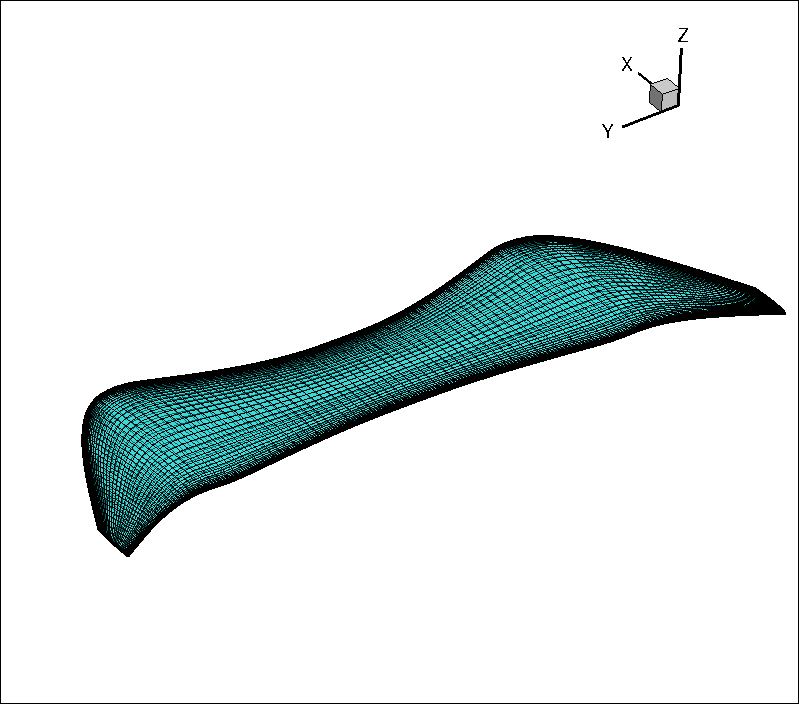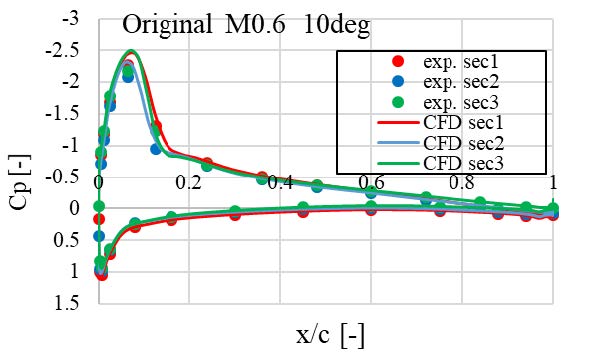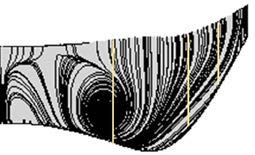High-Speed Rotorcraft Research
JAXA Supercomputer System Annual Report April 2020-March 2021
Report Number: R20EA3304
Subject Category: Aeronautical Technology
- Responsible Representative: Yoshikazu Makino, Aeronautical Technology Directorate, Aviation Systems Research Unit
- Contact Information: Yasutada Tanabe(tan@chofu.jaxa.jp)
- Members: Yasutada Tanabe, Hideaki Sugawara, Masahiko Sugiura, Keita Kimura, Kuniyuki Takekawa
Abstract
Compound helicopter is one of the high-speed rotorcraft concepts. On the high-speed compound helicopter, rotor revolution is slower than the conventional helicopters, considering the effect of compressibility at the blade advancing side. In this case, a reverse flow region whose inflow comes from the trailing edge of the rotor blade spread at the blade retreating side. Blade shapes which balance hovering performance and high-speed performance is desired in this complicated flow. This study aims to evaluate the aerodynamic performances of the optimal blade shapes designed by JAXA through numerical simulations.
Reference URL
Please refer to https://www.aero.jaxa.jp/eng/research/frontier/rotary/ .
Reasons and benefits of using JAXA Supercomputer System
Reason: There are many simulation cases, and the system is needed to get results efficiently.
Advantage: Large-scale simulation that requires much memory can be performed, and the results can be obtained efficiently.
Achievements of the Year
Numerical simulation regading blade tip shapes of the optimal rotor (high mu rotor) is conducted. Rotorcraft CFD code rFlow3D developed by JAXA is utilized in the simulations. The numerical grids are moving overlapped grids. Figure 1 shows grids used in the simulations. Overlapped grids consist of blade grids, inner/outer background grids.
Blade tips of three kinds of high mu rotors and a conventional helicopter rotor are computed to understand aerodynamic characteristics. Mach number and angle of attack of the blade tips are varied, considering rotor trim conditions. One of computational examples with experimental values is shown in Fig. 2. It is seen from this figure that the pressure distributions of computation correspond extremely well with experiment. And figure 3 describes an example of the flow visualization on a blade. A vortex due to separation is seen on the blade. This vortex is observed in the experiment, too.
In this numerical simulation, it is found that high mu rotor with swept back angle shows the highest performance, comparing aerodyanmic performances of the rotors comprehensively.
Publications
– Oral Presentations
Masahiko Sugiura, KOBIKI Noboru, Yasutada Tanabe, Hideaki Sugawara, Keita Kimura (JAXA), and Kuniyuki Takekawa (Ryoyu Systems), “Aerodynamic Characteristics of Optimal Rotor Blade Tip for High Speed Compound Helicopter,” 58th Aircraft Symposium (online), Nov. 27, 2020.
Usage of JSS
Computational Information
- Process Parallelization Methods: N/A
- Thread Parallelization Methods: OpenMP
- Number of Processes: 1
- Elapsed Time per Case: 140 Hour(s)
Resources Used(JSS2)
Fraction of Usage in Total Resources*1(%): 0.29
Details
Please refer to System Configuration of JSS2 for the system configuration and major specifications of JSS2.
| System Name | Amount of Core Time(core x hours) | Fraction of Usage*2(%) |
|---|---|---|
| SORA-MA | 101,553.56 | 0.02 |
| SORA-PP | 324,001.02 | 2.54 |
| SORA-LM | 65.83 | 0.04 |
| SORA-TPP | 59,698.71 | 5.63 |
| File System Name | Storage Assigned(GiB) | Fraction of Usage*2(%) |
|---|---|---|
| /home | 3,603.33 | 3.30 |
| /data | 6,886.43 | 0.13 |
| /ltmp | 955.59 | 0.08 |
| Archiver Name | Storage Used(TiB) | Fraction of Usage*2(%) |
|---|---|---|
| J-SPACE | 6.24 | 0.21 |
*1: Fraction of Usage in Total Resources: Weighted average of three resource types (Computing, File System, and Archiver).
*2: Fraction of Usage:Percentage of usage relative to each resource used in one year.
Resources Used(JSS3)
Fraction of Usage in Total Resources*1(%): 0.42
Details
Please refer to System Configuration of JSS3 for the system configuration and major specifications of JSS3.
| System Name | Amount of Core Time(core x hours) | Fraction of Usage*2(%) |
|---|---|---|
| TOKI-SORA | 132,577.81 | 0.03 |
| TOKI-RURI | 545,759.93 | 3.12 |
| TOKI-TRURI | 154,024.03 | 12.41 |
| File System Name | Storage Assigned(GiB) | Fraction of Usage*2(%) |
|---|---|---|
| /home | 4,602.21 | 3.15 |
| /data | 12,181.43 | 0.20 |
| /ssd | 1,082.17 | 0.57 |
| Archiver Name | Storage Used(TiB) | Fraction of Usage*2(%) |
|---|---|---|
| J-SPACE | 6.24 | 0.21 |
*1: Fraction of Usage in Total Resources: Weighted average of three resource types (Computing, File System, and Archiver).
*2: Fraction of Usage:Percentage of usage relative to each resource used in one year.
JAXA Supercomputer System Annual Report April 2020-March 2021





